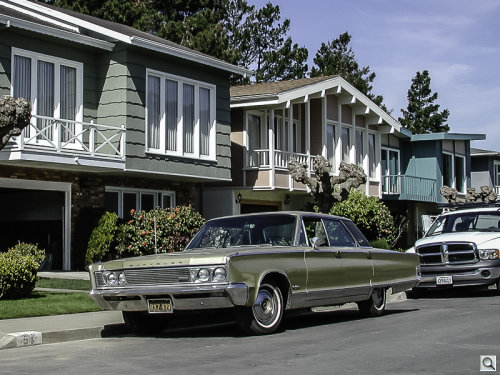Photo Corners headlinesarchivemikepasini.com
![]()
A S C R A P B O O K O F S O L U T I O N S F O R T H E P H O T O G R A P H E R
![]()
Enhancing the enjoyment of taking pictures with news that matters, features that entertain and images that delight. Published frequently.
Friday Slide Show: 1966 Chrysler New Yorker



2 August 2019
If you ever thought these Friday Slide Shows were an exercise in our vanity, today's presentation should correct that impression. It features what we can only call a disappointment. But if we learn from our failures, we can take encouragement from our disappointments.
There were several factors playing against us in this shoot. The dim light in the garage at midday, the dusty car itself and a new lens with which we were not entirely familiar.
We handled the dim lighting three different ways.
At first, we shot with available light from a side window and a back door near the front of the vehicle. Some compositions though required the overhead fluorescents to illuminate them. And for the interior we had to resort to the camera's built-in flash, which we diffused with a little toilet paper we found handy.
That made color correction a real hurdle. We used Lightroom's Eye Dropper tool to find a neutral and the unusual body paint color became recognizable again.
We also had to kick up the Color Luminance noise suppression to smooth out the shadows (particularly on the shot of the front fender).
There was nothing we planned to do about the car itself, though.
It hadn't been washed since 2003. And we hoped that would only enhance its aspect as an antique. It's 53 years old, after all, and should show it, especially in the dim light.
There are several factors playing against us in this shoot.
And the lens?
It was the M.Zuiko Digital ED 12-100mm f4.0 IS Pro we've been testing. Don't make too much of the image stabilization because the E-PL1 body is image stabilized and that is what was operative here, not the lens stabilization (although newer Olympus bodies can use both).
The f4 maximum aperture meant we were often shooting at a 1/10 second shutter speed. And that resulted in some camera blur that was hard to notice on the LCD.
So our exposures were extreme. And disappointing.
Our focal lengths ranged from 15mm to 66mm in close quarters. ISO was 1600 except for the flash shots, which fell between ISO 250 and 1000. Shutter speeds were between 1/6 and 1/20 second except flash at 1/60. And aperture was fixed at f4.
Composition wasn't a problem. We didn't crop any of these. The 12-100mm focal range of the Olympus gave us all we needed to frame the shot.
The idea for this shoot occurred to us looking over our collection and seeing a set of images of the beautiful old car. This Chrysler replaced the 1958 Plymouth Sport Suburban about the time we needed wheels to go to the prom.
Our grandfather had been very happy with his Chrysler Imperial (a land yacht if there ever was one) based on the elegant 1961 Lincoln Continental design of Elwood Engel. So Dad (who would have been 92 yesterday) shopped around for a Chrysler he could fit in the garage. This was it.
An elegant black interior, a goldish paint job. A full-aspirated, 440-cubic-inch behemoth under the hood. All we needed was a date.
We do have a confession to make, though.
Several cameras were used for these images, although the bulk of them are with the E-PL1 and the 12-100mm zoom. The first one, our favorite, was taken with a Nikon 990. The steering wheel hub (ISO 400) and lit dash (ISO 2500) were taken with a Canon PowerShot A3100 IS.
You might say we played the field. And learned from our mistakes.
